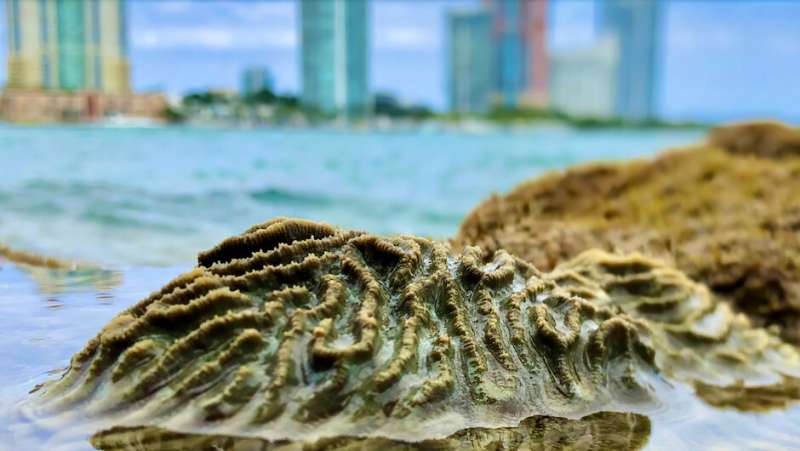This article has been reviewed according to Science X's editorial process and policies. Editors have highlighted the following attributes while ensuring the content's credibility:
fact-checked
peer-reviewed publication
trusted source
proofread
Port of Miami corals remarkably persistent, new study finds

Researchers at the University of Miami Cooperative Institute of Marine and Atmospheric Studies (CIMAS) and NOAA's Atlantic Oceanographic and Meteorological Laboratory (AOML) and partners found that the corals within the highly urbanized environment around the Port of Miami show great resilience against unfavorable conditions, such as poor water quality, excess nutrients, high temperatures, high salinity and low pH levels.
The Port of Miami is a bustling waterway with large cruise and cargo ships, ferries, fishing vessels, and recreational boats. These corals have built strong and diverse communities on human-made substrates, such as seawalls and discarded objects, according to the study published in Scientific Reports titled "Coral persistence despite marginal conditions in the Port of Miami."
"These corals are important because they are rare and threatened, but also because they demonstrate surprising resilience that can teach us about the future of coral reef ecosystems today," said Michael Studivan, a co-author of the study and a scientist at the Rosenstiel School's Cooperative Institute for Marine and Atmospheric Studies. "Corals persist despite conditions that would harm many reef species, including extreme temperatures, acidification, and poor water quality.
Scientists visited the Port of Miami over a three-year period beginning in 2018 to monitor environmental conditions and measure coral community dynamics. The research team used a suite of state-of-the-art instruments that included sub-surface autonomous samplers designed at CIMAS/AOML and coral photomosaics.
The samplers monitored the temperature, pH, oxygen, carbonate chemistry, light, and tidal flow at three reef sites. Photomosaics consisting of thousands of high-resolution underwater photos stitched together created detailed maps of these habitats to characterize their coral cover, spread, and species diversity.
Through a collaboration with Coral Morphologic's Coral City Camera, live underwater cameras were placed at an urban coral nursery site, which helped scientists to identify unique fish species visiting the site, including the endangered smalltooth sawfish.
"The Port of Miami is quite different from the places where we normally work. Everything is artificial, engineered, and constructed," said Ian Enochs, a research ecologist at AOML and lead author of the new study. "Somehow, nature has found a way to persist even in the most unnatural of environments."
More information: Ian C. Enochs et al, Coral persistence despite marginal conditions in the Port of Miami, Scientific Reports (2023). DOI: 10.1038/s41598-023-33467-7
Journal information: Scientific Reports
Provided by University of Miami





















